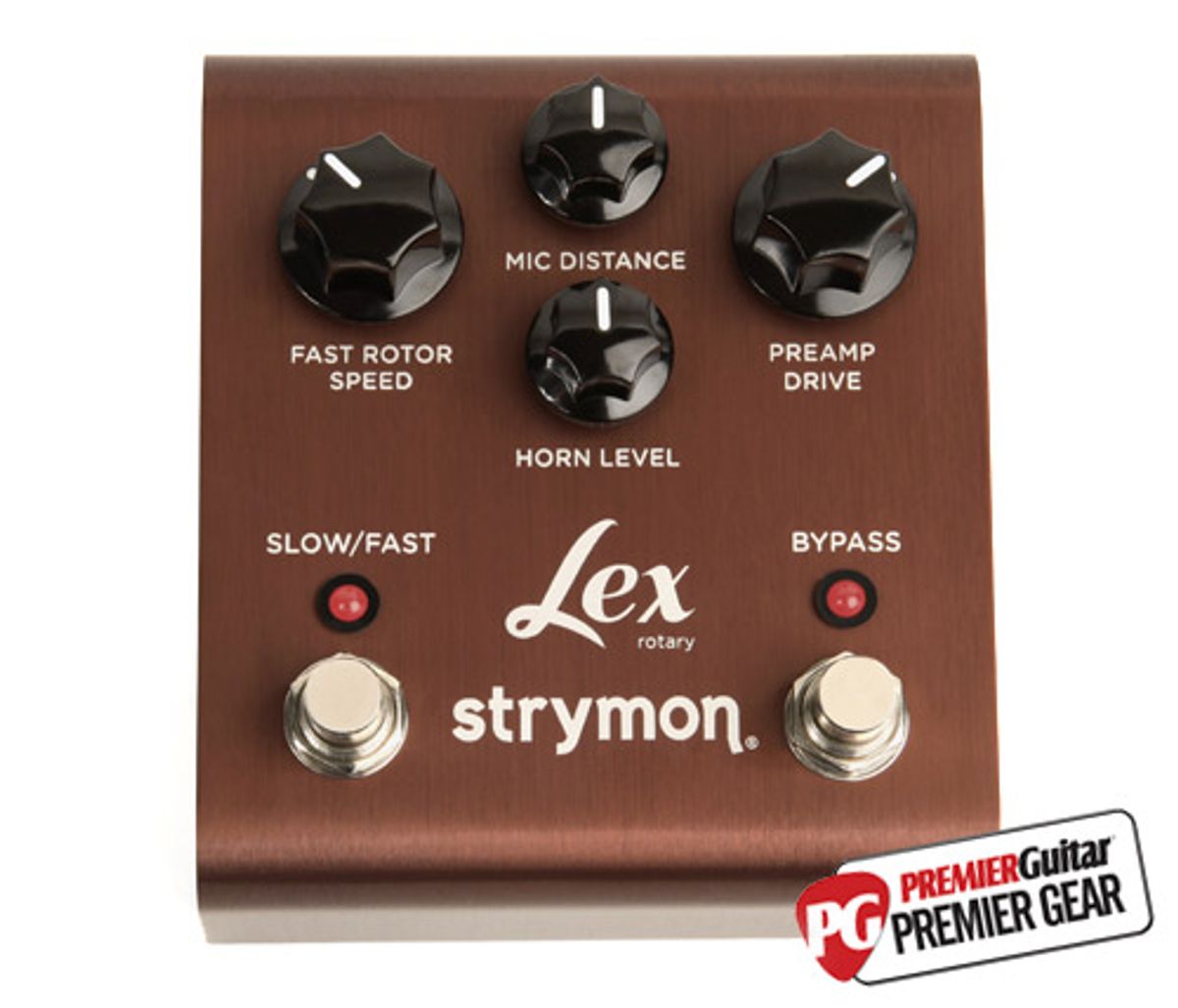The Lex nails a host of rotary speaker tone, but it also delivers a lot of the response and feel of playing one in impressive fashion.
| Download Example 1 Funky, fast then slow | |
| Download Example 2 Strat, fast then slow | |
| Clips recorded with a Fender Twin Reverb combo reissue and a 2008 Fender American Statocaster. | |
Since the ’70s, players have more often opted for choruses, phasers, and digital modulation pedals to replicate of sound of the heavy, expensive, and hard-to-maintain rotary speakers. But even the best modulation pedals have a hard time replicating the unmistakable sound of a spinning speaker and well-placed microphones that are responsible for the best rotary sounds. Enter the Lex, a new rotary speaker simulator from the brain trust at Strymon Effects. The Lex nails a host of rotary speaker tone, but it also delivers a lot of the response and feel of playing one in impressive fashion.
Where Do They Get These Wonderful Toys?
Like many of the pedals in the Strymon line, the Lex has a smorgasbord of features and frills that almost border on the obsessive. The aim was to emulate every aspect a rotary speaker cabinet, including all of the sonic nuances of different microphone configurations, and the number of sounds on tap is amazing, Strymon’s impressive 24-bit SHARC DSP system really flexes its muscles in this new example, modeling the mechanical aspects of rotary speaker function, and the sonic signatures of the amplifiers and speakers themselves. There are analog input and output circuits to help warm up the tone of the emulation further. And it can be used in either mono mode, or in a super-spacious stereo mode that can be bi-amped.
Strymon’s ability to nestle so many tweakable parameters within such a simple, no fuss interface is remarkable. The front panel of the chocolate-colored enclosure features four knobs, each with a primary and secondary function. Pressing both of the footswitches at the bottom of the pedal at the same time provides access to the secondary functions, which can take some clever footwork but gets easy with a little care and practice.
The first of these controls, the Slow/Fast footswitch is one of the most useful and effective. It’s a quick way to move between the Lex’s two basic speeds—a fast, bouncy swirl like the tone of the lead melody in Soundgarden’s “Black Hole Sun” or Tom Petty’s “You Don’t Know How it Feels” and a slow, phasing pulse like the intro to Pink Floyd’s “Breathe.”
The Mic Distance knob adjusts the intensity of the rotary effect—approximating the effect that a sound engineer can get with different microphone positions. On a Leslie, for example, a microphone is normally placed on the lower rotor (the drum, which handles the low end) and the other on the higher rotor (the horn, which handles the high end). Needless to say, the variations and possibilities are endless, and the Strymon covers a lot of them. The Lex approximates this effect in stereo mode, and by selecting bi-amp mode, each output jack effectively becomes its own rotor—the sound of which can then be modified by adjusting the Mic Distance knob. The closer the mic is placed to the rotor, the louder and more intense the effect gets for a given rotor. Pull the mic further away (in the figurative sense) and the effect becomes more even and smooth. You can also choose between mic’ing either the front or back of the cabinet, which changes the phase pattern, in the secondary function mode.
The Lex’s emulated preamp can be overdriven via the Preamp Drive knob, and either boosted or cut by 6 dB in its secondary function. The high end of the effect can be adjusted by moving the Horn Level knob, and the acceleration time between each rotation can be altered when the pedal is placed in its secondary mode. If there weren’t control and tone variations enough, each of the four front panel controls can also be controlled with an expression pedal and altered in real-time.
Super Smooth
While it’s easy to get caught up in the plethora of frills and tweakable parameters that the Lex has to offer, it’s also really difficult to get it to sound anything other than totally cool. The combination of a 2008 Fender American Telecaster and a Bogner Barcelona combo, and the Strymon on Fast mode with the controls set to noon was a match made in heaven. The Lex gave each note of a gingerly-picked chord melody weight, bounce and texture that sounded shockingly like a real rotating horn. There were no sharp edges to the virtual rotation or any hints that DSP was at work—just round, full and flat-out cool sounding pulses. Thanks to its high processing power, the Lex is capable of producing some really fast rotary sounds—topping out at more than eight rotations a second that never sound clipped, harsh, or angular.
Moving from Fast to Slow speed provided one of the most startling displays of how authentically the Lex can replicate the mechanical workings of a rotary speaker. Rather than simply flipping over to a slower speed in a cold and unnatural way, the effect actually tapered in real time just as a decelerating rotor would. To my surprise, the voicing of the tone changed noticeably as well. And the quick, pulsating, underwater bursts were replaced with an utterly flooring, phase-like sweep that felt like it was an integral part of the whole guitar tone, instead of just sitting on top of it.
That kind of variable effect on tone color is one of the Lex’s real strong suits. The Horn Level parameters in particular were most impressive—offering subtle and extreme shifts in tone textures as I scrolled through the knob’s sweep—and the Cab Direction control's ability to select front or back opened up even more options. Using the Mic Distance and Horn Level controls together really helped me find the perfect voice for my more trebly Telecaster. If I needed more bite on the upper end of the rotary effect, I just brought up the Horn Level and backed off a bit on Mic Distance to lend some expansiveness to the detail.
The Lex gave each note of a gingerly-picked chord melody weight, bounce and texture that sounded shockingly like a real rotating horn. There were no sharp edges to the virtual rotation or any hints that DSP was at work—just round, full and flat-out cool sounding pulses.
I figured that I could muddy the Lex if I boosted the internal preamp gain to its maximum setting. But even at this extreme setting, the Lex was amazingly forgiving. The Preamp Drive control has quite a bit of overdrive on tap, though it probably won’t replace your overdrive pedal if you need more modern or aggressive grit. It’s voiced with a bouncy, clear midrange, with a smooth, rolled-off top end—similar to that of a cranked low-watt amp like a ’60s Fender Princeton. On top of sounding great, it was also super responsive to my pick attack. Even the higher output of a Les Paul failed to obscure the detail of the rotary effect. And blues and blues-rock enthusiasts that love the sound of a barking tweed or blackface should give the Lex’s internal overdrive a shot before plugging in their beloved vintage overdrive pedals—it really sounded that rich and natural.
The Verdict
Even if a real rotary speaker cabinet wasn’t a huge pain to carry around, maintain, and store, the Lex would still be rather formidable opponent. Its ease of use and flat out killer tone put it in the upper echelon of rotary emulators. And after playing with the pedal on a single setting for over several hours, I had really forgotten that I was working with a pedal emulator—it just felt and sounded that real. It’s a trick that Strymon has pulling off with great success of late—no mean feat when it comes to the complex sounds of a rotary speaker.
Watch the video review:
Buy if...
you want one of the most authentic rotary emulators on the market today.
Skip if...
you prefer paying a crew of ten roadies to haul your Leslie.
Rating...
Street $300 - Strymon - strymon.net |



